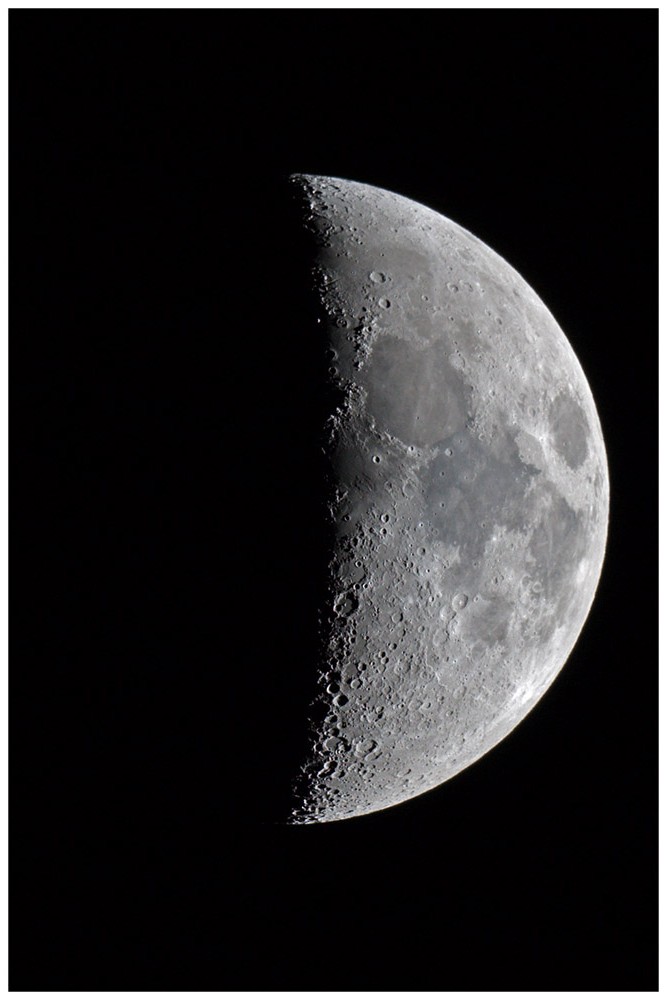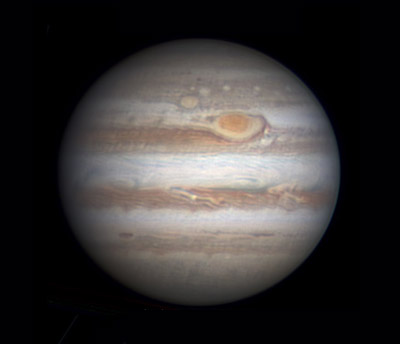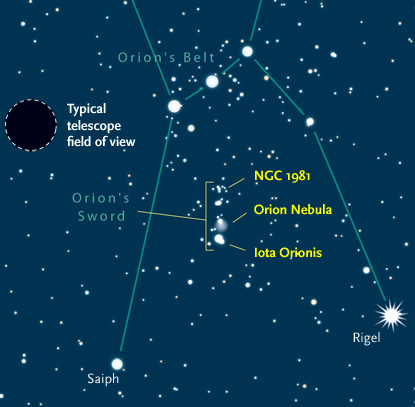If you're now the proud owner of your first astronomical telescope, you're eager to use it outside. Here are some can't-miss targets now visible in the sky.

This gift-giving season maybe you got a shiny new telescope to call your own. Congratulations — you're on your way to discovering many amazing things in the night sky. Whether it's a long, sleek tube or a compact marvel of computerized wizardry, every new telescope surely has an owner itching to try it out.
"Here are three important tips for getting started," advises Alan MacRobert, a senior editor at Sky & Telescope magazine.
"First, get your scope all set up indoors, read the instructions, and get to know how it works — how it moves, how to change eyepieces, and so on — in warmth and comfort.
"Second, take it out in the daytime and get familiar with how it works on distant scenes — treetops, buildings — to get a good sense of what it actually does. For instance, you'll find that its lowest magnification gives the brightest, sharpest, and widest views, and with the least amount of wiggles. It's much easier to find what you're trying to aim at using the telescope's lowest power. That's what you'll always want to start off with. Then switch to a higher power after you've found your target, got it centered, and had a good first look.
"Also, if the telescope has a little finderscope on the side, daytime is the easiest time to align the finderscope (using its little adjustment screws), so that it points at the same distant treetop as the main telescope. Don't try to figure out unfamiliar knobs, settings, and adjustments for the first time in the dark.
"Third," he adds, "be patient. Spend time with each sky object you're able to find, and really get to know it." Too many first-time telescope users expect Hubble-like brightness and color in the eyepiece — when in fact most astronomical objects are very dim to the human eye. And our night vision sees almost everything as shades of gray. Much of what the universe has to offer is subtle, and of course extremely far away.
On the other hand, the Moon and planets are bright and easy to find. These make excellent first targets for new telescopic observers. Sky & Telescope's This Week's Sky at a Glance always has suggestions for both telescope and naked-eye viewing of the brightest stars and planets.
Here are some suggestions for starting off.
New-Telescope Delight: The Moon
The Moon is one celestial object that never fails to impress in even the most humble scope. It’s our nearest neighbor in space — big, bright, starkly bleak, and just a quarter million miles away. An amateur telescope and a good Moon map can keep you busy on the Moon forever.
During the last week of December 2014, the waxing Moon is beautifully placed in the evening sky. Use your telescope to explore its thousands of impact craters and the big, darker-gray lunar "seas," vast lava plains that formed 3 to 4 billion years ago. (Almost all of the Moon's landforms are far older than any lands on our active Earth.) Mountains and craters will appear in sharpest relief along the line dividing lunar day and night, called the terminator. Here the sunlight comes in at a low slant, making shadows stand out starkly.
For guided tours of lunar features to seek out, see our online articles Take a Moonwalk Tonight and A Month of Moonwatching.
Jupiter

Jupiter, brighter than any star, currently rises around 8 or 9 p.m. and shines in good view high in the east by 11 p.m. or midnight. "Jupiter is the king of the planets and the most interesting one for a small telescope," says MacRobert. "It's big, it's bright, it has cloud belts, and it has four moons that do interesting things."
Even at 50× or 100×, you should be able to make out two dusky-tan bands girding Jupiter's midsection. These North and South Equatorial Belts, the bright Equatorial Zone between them, and Jupiter's lesser belts and zones are cloud features akin to jet streams, high in the Jovian atmosphere. (Jupiter is a gas giant with no solid surface.)
Larger telescopes — those whose main mirror or lens is at least 6 inches across — might bring a few more belts and zones into view, along with an assortment of spots and streaks. The famous Great Red Spot, a huge cyclonic storm larger than Earth, is actually rather pale orange-tan now and can easily be overlooked even when it's on the side of the planet facing us. Jupiter rotates in just under 10 hours (causing its globe to bulge out visibly at the equator), and the Red Spot is easiest to see when it crosses the midline of Jupiter's disk. You can find the times when this happens during nighttime for you using our online app.
With your first look at Jupiter, you'll immediately notice the array of bright moons on either side of it, roughly aligned with the belts. These are the four "Galilean satellites," named for Galileo, who discovered them from Italy in 1610. "Over time you'll notice their movement as they shuttle around Jupiter," notes MacRobert. "Sometimes not all four are visible: occasionally one of them ducks behind Jupiter or is hidden in its shadow." Their own tiny black shadows sometimes cross Jupiter's face. How can you tell which moon is which? We've got an app for that too!
For more about what to look for on and around Jupiter, check out our Jupiter observing guide.
Other New-Telescope Sights
There's more to the night sky than the nearby Moon and planets, of course. Winter evenings often bring crisp, transparent skies with a grand canopy of stars. But with so many inviting targets overhead, where should you point first?

The familiar constellation Orion climbs in the southeast after dark. In its middle, look for the three-star line of Orion's Belt; it's currently nearly vertical in early evening, and it's diagonal (like on the chart at right) late at night.
Just a few degrees south of the Belt runs a smaller, dimmer line: Orion's Sword. Within it lies the Orion Nebula, a luminous cloud of gas and dust where stars are forming by the hundreds. It shows pink in photographs, but dim gray with a hint of green to the human eye. The nebula is plain in any telescope once you get pointed at it, and so is the tight quartet of stars near its center, called the Trapezium. Astronomers sometimes refer to this nebula as Messier 42 (M42), and you might see it labeled that way on star charts. Located about 1,400 light-years away, it's the closest massive star-forming nebula to Earth.
You can use Orion's Belt as a pointer to other things. Extend the line far upward, past the relatively bright star Aldebaran (the orange-red eye of Taurus, the Bull) and you'll reach a little cluster of stars called the Pleiades. It's about the size of your fingertip held at arm's length.
According to Greek mythology the Pleiades were the seven daughters of Atlas and Pleione. Their names — lovely, exotic, and difficult to pronounce — are Alcyone, Celaeno, Electra, Maia, Merope, Sterope, and Taygeta. The Pleiades are also known as the Seven Sisters. In Japanese the cluster is called Subaru — look for them (distorted and stylized) on the car's logo.
Through binoculars or a telescope at low magnification, the Pleiades cluster shows dozens of stars. Astronomers have found that the entire cluster has about 500 in all. The Pleiades are bound together by their mutual by gravity as well as by legend. Collectively called an open cluster for their relatively uncrowded arrangement, they move together through space as a swarm. They're about 440 light-years away.
Researchers have determined that the Pleiades began to shine roughly 70 to 100 million years ago. This makes the stars mere toddlers compared to our Sun and solar system, age 4.6 billion years. M45’s youthful suns are astonishingly energetic. Alcyone (al-SIGH-oh-nee), the brightest, is at least 350 times as luminous as our Sun. Like the other Pleiads it gleams with an intense blue-white light — a sign that it’s unusually hot and massive.
To find much else in the night sky, you'll need a good, detailed star atlas (set of maps), such as the widely used Pocket Sky Atlas; a good deep-sky guidebook; and some practice in how to use the maps to locate things with your telescope. There are certain key tricks to this — see our article Using a Map at the Telescope.
And if you haven't done so already, start learning the major constellations in your evening sky as they appear to the naked eye. The best monthly evening constellation map that we know is the one in the center of each issue of Sky & Telescope magazine. The constellations are the framework you will need for locating smaller, fainter sights to pinpoint for your scope — the same way you need to know the continents and countries on a globe of Earth before you can locate a town within one of them.
For more tips on skywatching and how to get the most out of your telescope, see our Observing section and Getting Started section.
Whatever else, stick with it! Nobody is born knowing this stuff. Everyone has to work their way into the hobby at their own comfortable pace, finding things to know and do and understand and not worrying about all the things they don't. The universe is like that.
 4
4
Comments
Ted-Blank
December 27, 2014 at 9:55 am
The description of the Orion Nebula in the article says it is plain in any telescope, but don't interpret this the wrong way - it is plain to see (i.e. easy to find) but glorious to look at! And the darker the location you view from, the more detail you will see in it. (This really means that a dark sky will help, but dark skies usually go with dark places). Finally, it's possible that you got a scope whose mount is so light and flimsy that even trying to focus it makes the image wiggle around, making viewing impossible. If you suspect this, bring it to a meeting of your local astronomy club and ask if anything can be done to help stabilize it. Many times just a simple fix will make a huge difference.
You must be logged in to post a comment.
DrDale
December 27, 2014 at 2:28 pm
I got a telescope for christmas, and first it worked fine when I looked upon some stars. But two nights later I can't see anything with it! I'm aiming at the moon but even that doesn't work. What should I do?
You must be logged in to post a comment.
Todd
December 28, 2014 at 12:21 pm
DrDale
there are a number of possibilities, some of which may depend on what type of telescope you have. The most obvious would be if you may have inadvertently left a lens cap over the objective lens or eyepiece. Assuming you've not made that mistake, it is possible that the finder scope has gotten so out of alignment with the scope that it is no longer pointing the main tube at the moon or stars you think you should be seeing. Best to sort this kind of error out in the daylight with a distant antenna or church steeple until you get the finder and scope well aligned. Ideally the alignment should be done with a easily recognized target at least several hundred yards away to reduce parallax when aligning the finder. Another possible cause with Newtonian reflectors is misalignment of the secondary mirror. This small straight mirror captures the light coming from the main mirror and directs it out the side of the tube where the eyepiece is located. If you have one of these types of scopes, check to see that this is lined up ok (a flashlight can help with this, but adjusting a newtonian or dobsonian scope can be tricky). Another cause could be that the eyepiece adjustment is so far out of focus that the stars or even moon aren't recognizable. This could be due to taking out or putting in a diagonal or erecting prism, switching between eyepieces, or bumping the eyepiece holder between viewing sessions. Again, working with the scope in the daylight and focusing on a distant tree, antenna or building will help you get the focus close.
Be patient, and good luck!
Todd
You must be logged in to post a comment.
DrDale
December 30, 2014 at 10:26 am
Thanks for answering!
I managed to see the moon and some other stars in the telescope the day after it stopped working, but I don't know how I did it. I have a newtonian telescope and the mirrors are aligned. I will try to align the finder scope with the scope, and see if anything improvs.
Thanks for the help!
You must be logged in to post a comment.
You must be logged in to post a comment.